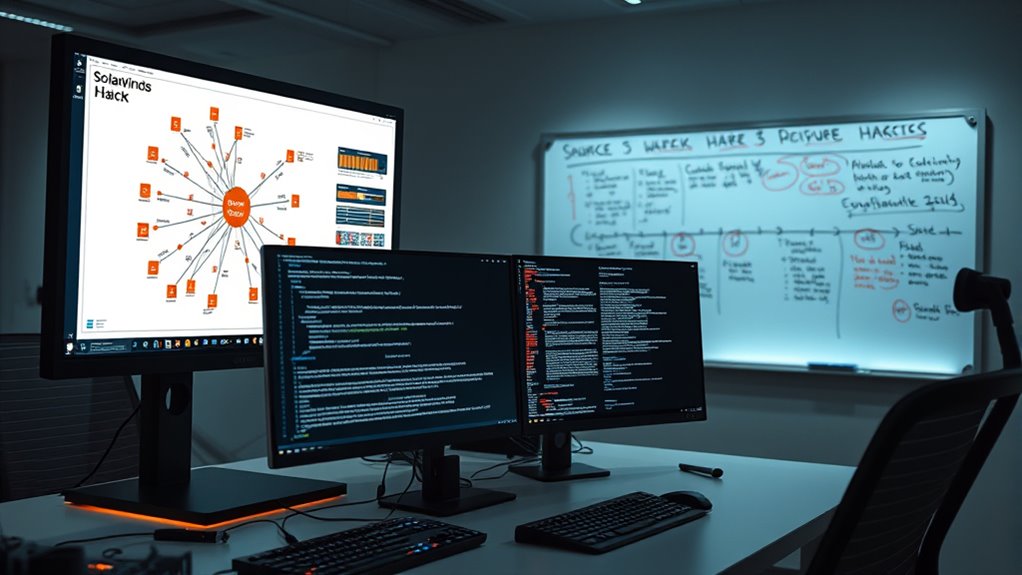Five years after the SolarWinds hack, you should recognize that supply chain vulnerabilities pose significant risks. Attackers employ stealth and persistence, targeting trusted vendors to access confidential data across organizations. Relying solely on traditional security measures isn’t enough; you need layered defenses, proactive risk management, and continuous monitoring. Understanding these lessons helps you strengthen your defenses against future threats. Stay tuned to discover more ways to protect yourself from evolving cyber espionage strategies.
Key Takeaways
- Rigorous supply chain security measures are essential to prevent trusted vendor compromises from escalating into widespread breaches.
- Continuous monitoring and proactive assessments help detect vulnerabilities early in complex supply chain environments.
- Traditional security tools alone are insufficient; layered defenses and active third-party risk management are critical.
- Trust must be balanced with verification, emphasizing transparency and collaboration with partners to mitigate risks.
- The attack underscores the need for ongoing vigilance, adaptive defenses, and comprehensive incident response planning.

What have we really learned five years after the SolarWinds hack? The most glaring lesson is that supply chain vulnerabilities pose a significant threat to national security and corporate stability. When hackers infiltrated SolarWinds’ software development process, they exploited a trusted supply chain, turning a widely used IT management platform into a backdoor for cyber espionage strategies. This attack revealed how adversaries can leverage trusted vendors to access sensitive data across multiple organizations, highlighting the need for rigorous supply chain security measures. You now realize that even the most seemingly secure vendors can become weak links if their defenses aren’t airtight. The SolarWinds breach underscored that security isn’t just about protecting your own perimeter but also about scrutinizing every link in your supply chain. Attackers have become more sophisticated, employing cyber espionage strategies that go beyond simple malware. They use stealth, persistence, and advanced techniques to remain undetected for months or even years, gathering intelligence gradually. This approach allows them to map out organizational structures, identify key personnel, and access confidential information without raising alarms. You’ve learned that relying solely on traditional security measures—firewalls, antivirus, or intrusion detection—is no longer enough. Instead, you need a thorough understanding of your supply chain’s cybersecurity posture and active monitoring of third-party vendors. Recent developments in penetration testing demonstrate how offensive security assessments can help identify vulnerabilities before malicious actors do. The SolarWinds incident was a wake-up call, emphasizing that security must extend beyond your own systems to include your partners and suppliers. Cyber espionage strategies have become more targeted, often involving nation-state actors who are well-funded and highly skilled. They understand the importance of patience and precision, making detection difficult until the damage is done. As a result, organizations now prioritize supply chain risk management, implementing stricter vetting processes and continuous monitoring protocols. You’re also aware that incident response plans need updating, with a focus on supply chain disruptions and espionage detection. The SolarWinds attack proved that a single compromised vendor can cascade into a widespread breach, affecting thousands of organizations. This knowledge urges you to foster transparency and collaboration with partners, share threat intelligence, and adopt proactive defense strategies. Ultimately, five years later, it’s clear that understanding and mitigating supply chain vulnerabilities isn’t optional anymore. Cyber espionage strategies continue to evolve, demanding a layered, resilient approach to cybersecurity. You can’t afford to be complacent; instead, you must stay vigilant, keep learning, and adapt to the changing tactics of today’s threat actors. The SolarWinds hack has left us with a crucial lesson: in cybersecurity, trust but verify has never been more relevant.
Frequently Asked Questions
What Specific Vulnerabilities Did Solarwinds Exploit?
You should know that SolarWinds exploited software vulnerabilities in their Orion platform, specifically through a malicious update that bypassed security checks. This attack revealed weaknesses in patch management, as the compromised update was distributed widely before detection. By exploiting these vulnerabilities, hackers gained access to numerous organizations’ networks, highlighting the importance of regularly updating and patching software, and maintaining robust security protocols to prevent similar breaches.
How Has Solarwinds Improved Its Security Measures Since the Attack?
Since the attack, SolarWinds has strengthened its security measures by adopting cybersecurity best practices and updating its incident response strategies. You’ll notice they’ve implemented multi-factor authentication, enhanced network monitoring, and improved software development processes. These steps help detect threats early and respond swiftly. By focusing on proactive defense and thorough incident response, SolarWinds aims to prevent future breaches and protect customer data more effectively.
Were Any Government Agencies Targeted Specifically?
You should know that several government agencies were specifically targeted in the SolarWinds hack, highlighting the importance of strong cybersecurity policies. Imagine hundreds of government systems compromised; that’s what happened. Since then, agencies have intensified efforts to detect insider threats and improve defenses. This attack underscores how critical it is to stay vigilant, update cybersecurity policies regularly, and monitor insider threats to prevent future breaches.
What Legal Actions Resulted From the Solarwinds Breach?
You should know that the SolarWinds breach led to significant legal consequences, including multiple investigations and lawsuits. Several government agencies and private companies faced class action suits, holding SolarWinds and related parties accountable. These legal actions aim to recover damages and improve cybersecurity standards. While some cases are ongoing, the breach underscored the importance of robust legal frameworks to address large-scale cyberattacks and their repercussions.
How Can Organizations Better Detect Supply Chain Attacks?
To better detect supply chain attacks, you should focus on managing third-party risks and leveraging threat intelligence. Continuously monitor your vendors’ security practices and establish strong vetting processes. Use threat intelligence to stay informed about emerging vulnerabilities and attack methods. Implement advanced detection tools like anomaly detection and network monitoring, and regularly conduct security assessments to identify potential weaknesses before attackers exploit them.
Conclusion
Five years after the SolarWinds hack, it’s almost ironic how the lessons learned echo the very unpredictability of cybersecurity. Just as a seemingly minor oversight can lead to major breaches, today’s small precautions can prevent tomorrow’s disasters. Coincidentally, staying vigilant now guarantees you’re not caught off guard later. Remember, in cybersecurity, the smallest detail often makes the biggest difference—so stay alert, because the next breach might just be around the corner.









